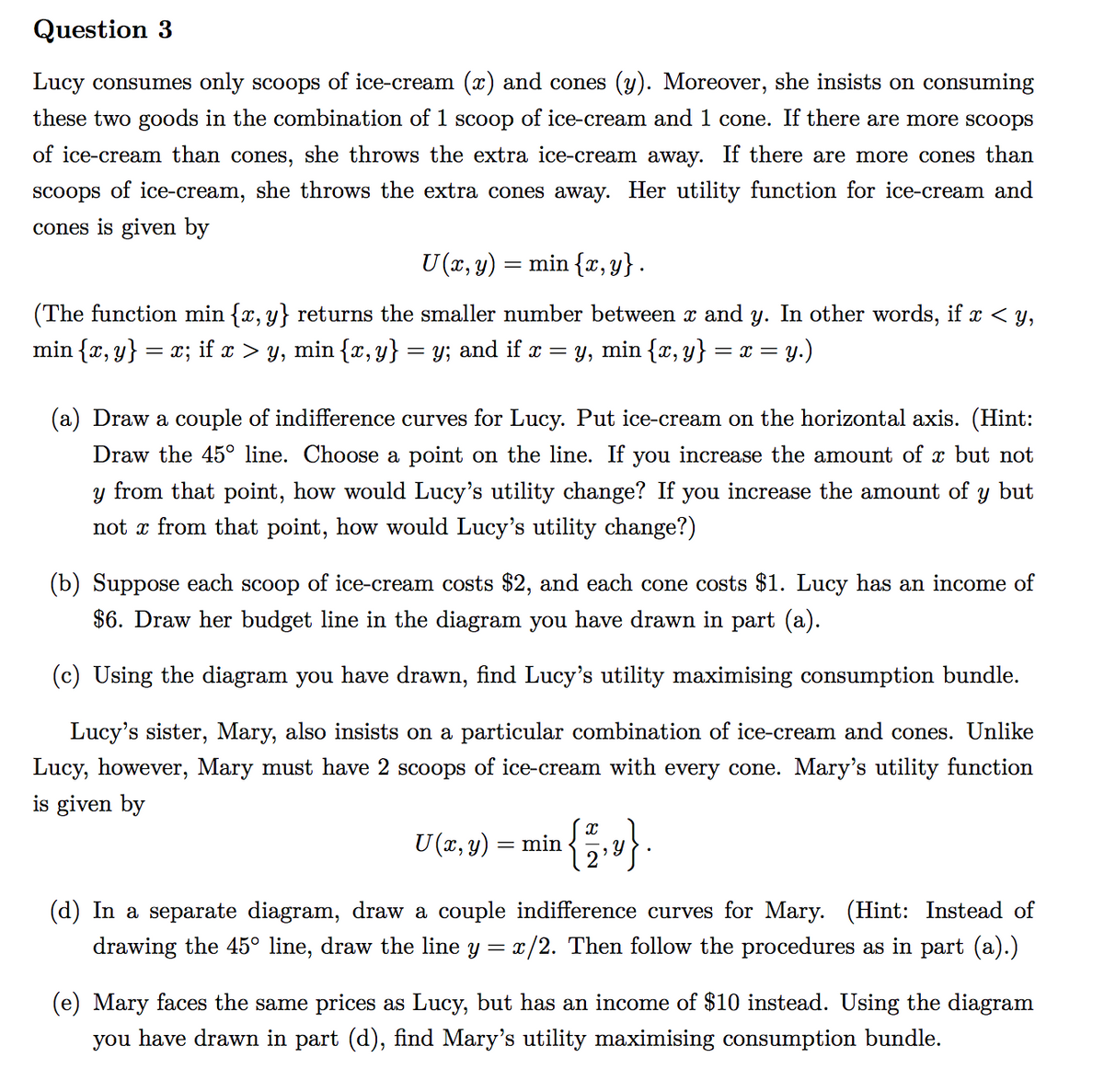Lucy consumes only scoops of ice-cream (x) and cones (y). Moreover, she insists on consuming these two goods in the combination of 1 scoop of ice-cream and 1 cone. If there are more scoops of ice-cream than cones, she throws the extra ice-cream away. If there are more cones than scoops of ice-cream, she throws the extra cones away. Her utility function for ice-cream and cones is given by U(x, y) = min {x,y}. (The function min {x,y} returns the smaller number between x and y. In other words, if x < y, min {x,y} = x; if x > y, min {x,y} = y; and if x = y, min {x, y} = x= y.)
Lucy consumes only scoops of ice-cream (x) and cones (y). Moreover, she insists on consuming these two goods in the combination of 1 scoop of ice-cream and 1 cone. If there are more scoops of ice-cream than cones, she throws the extra ice-cream away. If there are more cones than scoops of ice-cream, she throws the extra cones away. Her utility function for ice-cream and cones is given by U(x, y) = min {x,y}. (The function min {x,y} returns the smaller number between x and y. In other words, if x < y, min {x,y} = x; if x > y, min {x,y} = y; and if x = y, min {x, y} = x= y.)
Principles of Microeconomics
7th Edition
ISBN:9781305156050
Author:N. Gregory Mankiw
Publisher:N. Gregory Mankiw
Chapter21: The Theory Of Consumer Choice
Section: Chapter Questions
Problem 1PA
Related questions
Question

Transcribed Image Text:Question 3
Lucy consumes only scoops of ice-cream (x) and cones (y). Moreover, she insists on consuming
these two goods in the combination of 1 scoop of ice-cream and 1 cone. If there are more scoops
of ice-cream than cones, she throws the extra ice-cream away. If there are more cones than
scoops of ice-cream, she throws the extra cones away. Her utility function for ice-cream and
cones is given by
U(x, y) = min {x,y}.
(The function min {x,y} returns the smaller number between x and y. In other words, if x < y,
min {x,y} = x; if x > y, min {x,y} = y; and if x = y, min {x,y} = x = y.)
(a) Draw a couple of indifference curves for Lucy. Put ice-cream on the horizontal axis. (Hint:
Draw the 45° line. Choose a point on the line. If you increase the amount of x but not
y from that point, how would Lucy's utility change? If you increase the amount of y but
not x from that point, how would Lucy's utility change?)
(b) Suppose each scoop of ice-cream costs $2, and each cone costs $1. Lucy has an income of
$6. Draw her budget line in the diagram you have drawn in part (a).
(c) Using the diagram you have drawn, find Lucy's utility maximising consumption bundle.
Lucy's sister, Mary, also insists on a particular combination of ice-cream and cones. Unlike
Lucy, however, Mary must have 2 scoops of ice-cream with every cone. Mary's utility function
is given by
¹{2,}.
U(x, y) = min
(d) In a separate diagram, draw a couple indifference curves for Mary. (Hint: Instead of
drawing the 45° line, draw the line y = x/2. Then follow the procedures as in part (a).)
(e) Mary faces the same prices as Lucy, but has an income of $10 instead. Using the diagram
you have drawn in part (d), find Mary's utility maximising consumption bundle.
Expert Solution
This question has been solved!
Explore an expertly crafted, step-by-step solution for a thorough understanding of key concepts.
Step by step
Solved in 4 steps with 2 images

Knowledge Booster
Learn more about
Need a deep-dive on the concept behind this application? Look no further. Learn more about this topic, economics and related others by exploring similar questions and additional content below.Recommended textbooks for you

Principles of Microeconomics
Economics
ISBN:
9781305156050
Author:
N. Gregory Mankiw
Publisher:
Cengage Learning

Principles of Economics (MindTap Course List)
Economics
ISBN:
9781305585126
Author:
N. Gregory Mankiw
Publisher:
Cengage Learning

Exploring Economics
Economics
ISBN:
9781544336329
Author:
Robert L. Sexton
Publisher:
SAGE Publications, Inc

Principles of Microeconomics
Economics
ISBN:
9781305156050
Author:
N. Gregory Mankiw
Publisher:
Cengage Learning

Principles of Economics (MindTap Course List)
Economics
ISBN:
9781305585126
Author:
N. Gregory Mankiw
Publisher:
Cengage Learning

Exploring Economics
Economics
ISBN:
9781544336329
Author:
Robert L. Sexton
Publisher:
SAGE Publications, Inc


